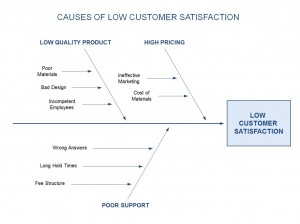

They help to identify potential sources of problems and, in doing so, to suggest solutions. Cause and Effect diagramsĬause and Effect diagrams are also known as “fishbone” or Ishikawa diagrams (after the Japanese professor who originally invented them) and are especially useful in project planning for gathering and identifying all issues that could cause problems. But the group also needs a strong leader to maintain focus and not let the discussions wander completely off-topic. It is often the inexperienced group member who asks basic questions that can get everyone thinking in a different way. It can be difficult for individuals used to a fairly disciplined way of working to approach brainstorming with an open enough attitude so the group involved has to be chosen with care and should certainly include people with no preconceived ideas about the topic in question – maybe even no knowledge of the project. While simple projects may be planned and controlled successfully using only a Gantt Chart, larger and more complex projects are likely to require all four techniques. The four most useful techniques for project planning are four techniques that complement each other and, when used together, provide the best chance of covering every aspect of the project. But which techniques are most effective for putting together a perfect plan? It will enable the project manager to easily assign tasks, monitor progress and costs as well as communicate project status to interested parties and produce reports.
#Project planning tools fishbone how to#
Want to learn more about how to effectively use fishbone diagrams? Check out this fishbone diagram tutorial. So go ahead and check out more fishbone diagram examples. But there are plenty more in our diagramming community. These are some of the industry specific fishbone diagram templates available to our users. Click on the image to edit the diagram.įishbone Diagram Template for Team Brainstorming Sessions (click to modify online) Want More Fishbone Diagram Templates The 6 Ms of manufacturing are already added to the branches. Not all of the branches might be relevant to your organization, so delete the unnecessary branches when editing the diagram. Fishbone Diagram Template for Team Brainstorming Sessionsįishbone Diagram Template for ManufacturingĪ fishbone diagram template that can be used in the manufacturing process.Fishbone Chart Template for Future Scenarios.Ishikawa Diagram Template on Inability to Meet Deadlines.Fishbone Template for Dissatisfied Employees.Fishbone Diagram Template for Marketing.Fishbone Diagram Template for Manufacturing.Just click on the images and we’ll open the templates as a diagram.

#Project planning tools fishbone download#
You can download them or modify them online using our diagramming tool. Below are some fishbone diagram templates from our diagramming community. Fishbone diagrams are used in many industries but primarily they’re used in manufacturing, sales, and marketing. They are a great way to visualize causes and their effects.

Fishbone (aka Cause and effect/Ishikawa) diagrams are great for analyzing processes and identifying defects in them.


 0 kommentar(er)
0 kommentar(er)
